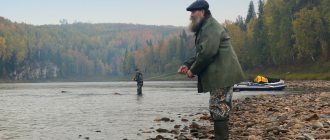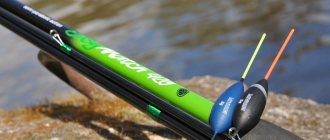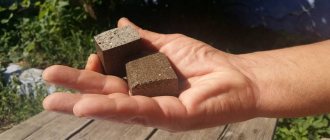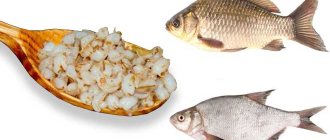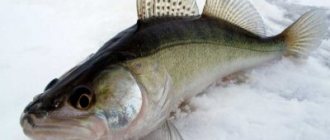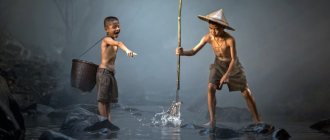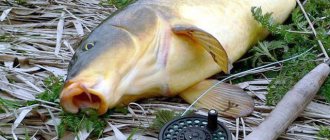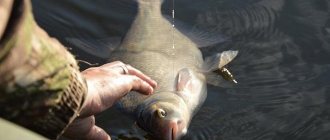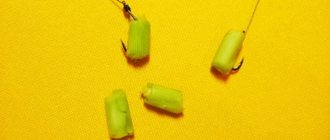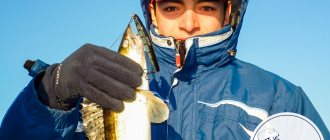Fishing in the spring during floods of rivers, lakes, ponds, and oxbow lakes has its own characteristics and, as a rule, does not please fishermen with excessive catches for several reasons, which will be mentioned below.
And, nevertheless, there will be a lot of fishermen who like to wander, often in waders, along the flooded spring banks of spring rivers, lakes, and oxbow lakes, hoping for at least some catch of fish.
The author of the site himself is one of the same “eccentrics” and, to be honest, I don’t remember a time when I returned home without a catch of fish. You just need to know where the schools gather in groups in front of the spawn and how you can reach and catch the fish coming to the spring spawning grounds.
I warn you right away. Before you start going fishing in open water in the spring, familiarize yourself with the restrictions and prohibitions that exist in your area regarding spring fishing standards.
You will need this in order to decide on the most promising gear with which you can get fish in the spring during the flood. The most promising gear for spring fishing is discussed in detail on the next page.
Spring fishing in high water
Fishing during the spring flood period can be divided into two stages. Early fishing in the spring begins with the intense melting of snow, which leads to a noticeable increase in water and ice breaking away from the shores of closed reservoirs.
Late spring floods are characterized by the absence of snow in open areas, although in thickets of forests islands of unmelted snow can be found until the end of May.
In rivers the ice has long disappeared, but in stagnant bodies of water - lakes, ponds, oxbow lakes - the thick ice cover can last until the spring May holidays. Fishing in the spring on a lake or river oxbow from ice cut off from the shore can bring very good fishing results.
Large flood waters, naturally, should somehow affect the behavior of the fish and, as a result, the result of spring fishing. But an even greater influence is exerted by turbidity, which in a lake, oxbow lake or pond settles near the shore, and in the course of the river rushes along the flowing reservoir to the mouth.
Fishing in muddy flood waters
I think it is no secret to any of the fishermen that fishing in the muddy waters of the spring flood a priori cannot be crowned with success for at least two reasons.
The smallest particles of debris clog the channels in the fish's gills, which are responsible for the supply of oxygen, and it begins to suffocate. In the spring, fish in the muddy water of a flooded river no longer see the baits on the hooks of fishermen’s gear.
Therefore, schools of fish in rivers rest in areas with weak or no current, where less turbidity is concentrated in the water. Usually these are backwaters, bays, areas around a bend in the river or a cape, where the fisherman must decide on a fishing spot in the flood of a spring reservoir using the available gear.
The influence of water profit on the prospects of fishing
The prospects for fishing during the spring flood are more than noticeably influenced by fluctuations in the water level in the reservoir, the profit of which largely depends on the warming of the air and the presence of rains, which literally wash away snow and ice.
And at the same time, the spring surplus of water creates new food pastures for fish from uneaten food along the banks of small rivers, oxbow lakes, lakes, and ponds, where you can find many places with melted, but clean water without turbidity for promising spring fishing.
Safe fishing on the lake in spring
Starting from the second half of April, safe fishing is guaranteed only from the shore of a lake or an oxbow river, but during my foolish youth three times I had the opportunity to actively participate in spring ice fishing at the height of the flood, albeit with the safety net of a rubber boat.
All cases occurred during the spring May holidays. They came to fish in the expanses of a small river that overflowed during the flood, but due to the impossibility of catching fish there, they immediately moved to a fairly large lake located nearby, where the fish that had come from the river at one time took root.
The result of the last such spring fishing: floundering in the ice slush, although relatively close to the shore of the lake, a copious libation on the occasion of salvation on the day of the national holiday and the early return of a wet hedgehog in the fog to his beloved family. And somehow managed not to lose his inflatable Swift.
Nowadays, that is, many years after the incident described above, during the spring flood period I usually take a short vacation at my own expense. And taking into account the May holidays, I have time to go fishing where I planned - on lakes, oxbow lakes and rivers.
I fish either from the shore or from a small boat with side rods with different equipment, fishing with which during spring floods has its own specifics or features. Below I will describe how I fish during spring fishing inside and at the outlet of the oxbow lake of the small river.
How do fish behave?
The behavior of fish during a spill is influenced by many factors. With strong currents, for example, aquatic inhabitants have to expend energy to avoid being carried away. When a fish moves a lot, it needs to eat more.
Opaque water helps anglers get very close to their target, as fish become less cautious in such conditions. They are less concerned about what is happening on the shore. You can use not the thinnest gear and still catch successfully.
Search for a place
Due to the spill, the landscape of the reservoir is changing. For a beginner, this arrangement of things can be discouraging. But you should look for a way out, there is always one.
Areas of shallows with weak currents should attract attention. In quiet, calm water, food particles sink to the bottom. The longer the water sits, the clearer and warmer it is. This is where the fish rush.
In such places, everything is clearly visible, so the angler must move quietly and slowly so as not to spook the fish standing in shallow water.
Fishing in high water with a spinning rod:
Spill fishing with a float:
Features of fishing in spring during high water
As mentioned above, fishing in the spring on floods has a number of rather unpleasant features, the first of which is that the area and depth of any reservoir during high water increases significantly with the same filling of fish individuals.
As a result: the number of even not very convenient places for catching active fish in a lake, pond or oxbow lake during the spring flood period is significantly reduced. This is especially true for reservoirs with low banks.
Second feature. In the spring, when the water floods, fish have a lot of new food supplies, which also leads to a decrease in the concentration of feeding fish per unit area of the reservoir, which naturally leads to a deterioration or unpredictability of fish biting throughout the spring.
The influence of water level on spring fishing
The best conditions for fishing occur during a period of short-term stabilization of the water level. Typically, a smaller influx of melt water is observed in early spring in the morning after the remaining snow and soil freeze at night.
But if the frost drags on and the water level of floods begins to drop noticeably, the fish, without hesitation, goes to the depths, apparently following natural instinct. In my opinion, fishing in the spring doesn’t get worse if you find a concentration of a school of cold-blooded fish deeper in a place that is clear of turbidity.
You can list a lot of features and reasons that do not at all contribute to the prospects of spring fishing, but the main ones are the melt water flowing from the coastal banks, constantly destabilizing the level of flood water, which is not transparent and does not have a temperature comfortable for the life of fish.
Tackle for fishing in the shallows of flood waters
In shallow areas of flood waters, shrubs and islands of last year's coastal hard grass are often found - the cause of snags on the hooks of fishing gear. Therefore, for fishing in the spring, long rods with shortened rigs are often used.
A factor that has a positive effect on the activation of biting during floods is the desire of fish to gain weight in the spring before the upcoming fast during the spawning period. Representatives of cold-blooded animals behave more actively on shallows warmed by the spring sun.
There, in the natural habitat, fish food, both animal and plant origin, develops faster. These shallow areas of rivers, lakes, ponds, and oxbow lakes become the most promising for spring fishing.
As you can see, despite all the features listed above, we have two to three weeks to enjoy fishing in the spring in high water before the spawning period of fish begins.
Lure
During high water, the fish stays closer to the bottom. Therefore, the bait must have sufficient weight and consistency so as not to disintegrate in the upper layers of water. To do this, you should add a larger volume of binding components, such as flour, oatmeal, rolled oats. Sand or clay is used as weighting agents. The color of the bait mixture for dark water should be light, and vice versa. The selected bait for fishing must be inserted into the bait. This will ensure that the fish get used to the sight and smell of the bait. In muddy water, a variety of aromatic additives work well to attract fish from long distances.
Fishing in spring on a river flood
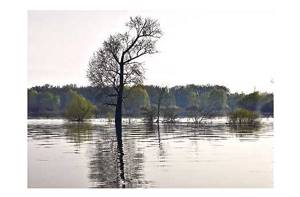
Fishing in early spring on a river flood begins with the water warming up to a certain temperature, when schools of predominantly one type of fish begin to crowd from large reservoirs into the floods of small rivers.
Next, most of the accumulated fish are forced to rise higher and higher in search of food pastures that have not yet been eaten. It is in such not very stable spill conditions that fishermen catch fish in early spring.
The main difficulty in catching fish during the spring flood is finding clean water on the river, not diluted with turbidity coming from the melted banks. Moreover, turbidity often appears in the current when the ice has not yet been torn off from the banks.
The water in the river is still clear before the intense snow melting begins, thanks to the soil frozen during the winter and often daily night frosts, which are good factors for successful fishing on the river in the spring.
Fishing in the spring floodplain
Fishing is most promising during floods in the floodplains of small rivers, where fish come in the spring with the benefit of melt water for at least two main reasons:
Thanks to the flooded banks, many new feeding areas with food unusual for the river bed appear here. In addition, in the backwaters and bays of a small flowing reservoir, already in early spring, many species of fish can choose a site to their liking for the upcoming spawn.
During the spring movement against the flow of the river, the bulk of the fish adheres to the edge of the vegetation and the bank edge of the flooded channel. This should not be confused with a bank flooded during spring floods. These are the most promising areas for fishing with a half-bottom and a jig.
The rigging of a half-bottom for fishing in the spring on a strong current in the river floodplain is presented on the next page of the topic. The prospects of the gear have been tested many times on the powerful currents of small rivers at the height of the spring flood.
Some of the fish enter flood lakes, in which, after the water subsides, they remain cut off from the river’s floodplain. The greatest interest for fishing in the spring is the mouths of channels and underwater depressions that open into the bays of small rivers.
Coastal fishing areas in spring
On any river in early spring, coastal areas with great depth are considered the most reliable for catching “white” fish. Places under the cliffs are characterized by weak currents and much cleaner water than in the river bed. Here, cold-blooded individuals, even if they do not find abundant food, can gain strength before the next struggle with the powerful spring current.
Excellent fishing on the river in the spring can be achieved by casting baits along the very edge of the flooded summer river bed. But here the question arises: how to find this edge in order to cast the spring bait so accurately?
If the river is not too polluted with turbidity, then the best place for fishing in the spring is considered to be the coastal areas of the mouth of a small river with a slow current, which fish passing to spawn cannot avoid. True, the fairy tale can last only two or three days.
In the spring, due to an unexpected change in weather, sometimes you have to wait a long time for such a favorable moment for fishing, setting up a parking lot with the prospect of living on the river bank for up to a week. When I was younger, we used to wait for a week for fish passing along the Rutka River.
Prohibitions on spring fishing from a boat
In many regions of Russia, a ban on spring fishing from a boat applies. Therefore, the fisherman who gets the school during the flood from the river bank with suitable gear will catch more fish.
Most suitable for these purposes is casting into the shallows along the bank of a river, lake or pond with the well-known fishing elastic. But here we run into a ban that limits the number of hooks allowed for fishing in the spring.
In this connection, I can share my experience of fishing in early spring on the channel of a small river below the Novocheboksarsk reservoir, where the current can change direction several times in a day.
In the morning I move on a rubber boat to the floodplain of the oxbow of a small river with a stream of water flowing from it, and fish with no more than two hooks either from the shore or from a boat. Bans don’t seem to concern me.
The guys from the fisheries inspection at this time are concerned about removing the nets installed by local residents overnight during the spring floods. For this reason, they pay zero attention to me, sitting in a small rubber boat with some antediluvian fishing rods and using primitive methods of catching fish using a couple of rigs. Their boats are already filled with removed nets with fish entangled in them.
Based on all of the above, I can share my experience of spring fishing in the oxbow river. Maybe this will be useful to fishermen who like to fish during floods.
Behavior of fish in high water
During this period, the behavior of fish is determined by various factors. When the current increases, for example, the fish spends more energy simply trying to stay in place. Therefore, in order to restore the strength that she wasted during the flood, she must eat intensively. Quite muddy water allows the angler to get much closer to the prey, since the fish are much less afraid in such conditions. The fisherman can safely use coarser gear and not stand on ceremony when fishing.
It should be noted that in significant currents, as a rule, the fish tries to stay as close to the bottom as possible. Therefore, sometimes it is simply necessary to use heavy equipment, which, by the way, is easier to fish with. However, fish can be caught not only when the water is falling, but also when it is rising. At this time, you should look for it in sections of the river where the negative factors mentioned above have been leveled out.
Search for fish
Due to floods, the landscape of rivers changes greatly. This state of affairs can confuse an unprepared fisherman. But try to find promising places, and you absolutely will not regret it. Particular attention should be paid to searching for fish closer to the water, as various particles are deposited when the flow is slow. The longer the water remains in a calm state, the faster and more it warms up. And as a result, there should be fish in such places. Visibility in shallow water is much better, so the fisherman must behave calmly and try not to spook his possible catch. In such areas, fish mainly adhere to the boundaries of fast muddy currents, as well as clear and slow water. Such places are ideal for resting and feeding fish.
It will be better if the angler carefully approaches the casting site and hides behind trees, bushes or other possible natural shelters. It is best to fish at the aforementioned boundaries. Also quite promising places for fishing are the mouths of tributaries and streams. In such places there are many interesting places that require the angler to have a somewhat non-standard approach to the fishing process - depth changes, areas with slow currents, various pressures to the shore.
Fish are attracted not only by shade and the possibility of shelter, they also like to stand under steep banks. Under the bank cliffs there is generally a moderate current and depth difference, as well as various features of the bottom topography. An angler who correctly casts bait to such shelters can easily count on a good catch.
The fish can also stand where, in the opinion of the angler, it should not be - for example, in the middle of a fairly powerful stream. It can be attracted to such a place by the unevenness of the bottom. You should try all options.
Float tackle
During high water, you can fish by walking along the shore and fishing the most promising areas, as well as stationary, in which case the fisherman lures and holds the fish using bait in the required area.
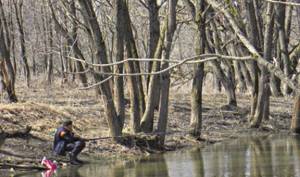
Fishing from the shore during high water
The fishing method depends not only on the preferences of the fisherman himself, but also on the width of the reservoir, the number of promising places in the area, the amount of vegetation, access to the shore, and, of course, the weather. For running fishing, it is best to use a Bologna or lead rod, the length of which is 5-7 meters; the tester of such a rod should be low, for example, 3-12 g. It will be good if the rings are located on long legs.
It is best to take a spinning reel, small in size, so that the fishing line has a diameter of 0.14-0.18 mm. It is best that it be specifically designed for long casts, for example, for match fishing.
The preferred diameter of the leash is 0.10-0.12 mm, and the length is 25-30 cm. It is best to connect it to the main fishing line with a small swivel No. 22-24. The hooks should have a good sharpening, size No. 14-18, depending on the size and type of bait and the activity of the fish.
When fishing on the go, you can use a variety of equipment rigs. When fishing in mid-water, when the hook with bait does not sink to the bottom, it is best to use floats that have an oblong shape with a medium-length metal keel and two attachment points. Installation of a simple type of load - one “pellet” every 15 cm.
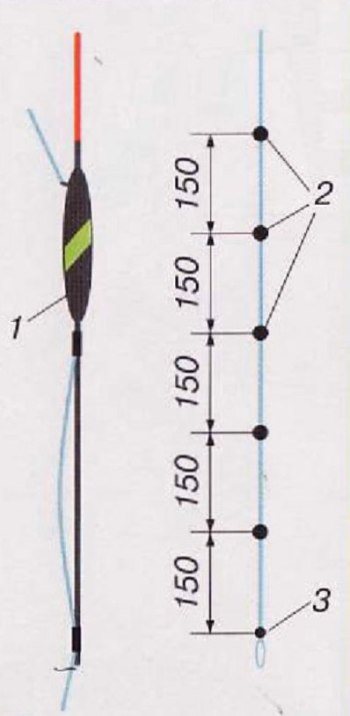
Installation of weights for running fishing
When the hook with bait touches the bottom, it is best to use sliding floats, and if the depth of the reservoir allows, floats that have two attachment points, and which are more stable and much more sensitive when fishing in the current. The load is quite simple - a sub-sink, 30 cm higher along the line - an intermediate sinker, and after 50 cm - the main sinker.
The choice of float capacity should be determined not only by the test of the rod and the strength of the current, but also by the planned activity of the fish. The principle is quite simple: the lighter, the better.
When stationary fishing, you can also use a wire (Bolognese) rod, but it is best to fish with a fly rod, the length of which is 5-8 meters, the action should be medium-fast, which, if necessary, would allow the use of thin equipment.
Feeder
In strong winds, you can use a feeder. First you need to determine how suitable your bottom gear is for the pond. This is a pretty important point! A variety of tackle may be needed, ranging from a light picker to a heavy feeder. The length should be chosen based on the fishing distance, the chosen location and other factors.
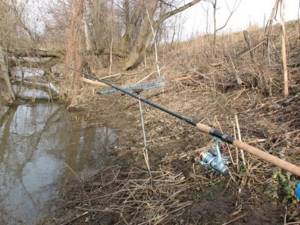
Fishing on a feeder
A few words about the installation of equipment. A simple way, but not the best, is an asymmetrical loop.

Installation of equipment with an asymmetric hinge
During currents, it is best to use mounting equipment with a plastic anti-twist. The main line can be monofilament, feeder or match, close in color, for picker and light feeder with a diameter of 0.14-0.16 mm, and for heavier gear 0.18-0.25 mm.
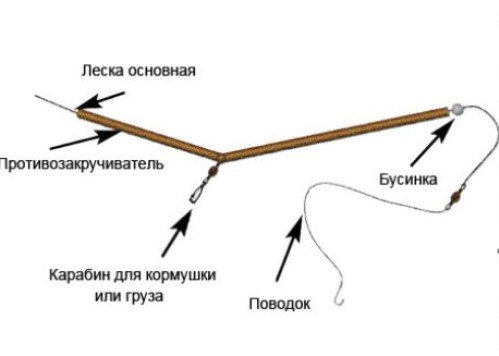
Installation of equipment with a plastic anti-twist
The thickness of the leashes is in the range of 0.10-0.18 mm, and the length should be selected based on experience. The more active the fish is, the shorter the leash should be used, and vice versa. It is not advisable to skimp on leashes: a good fishing line is a significant bid for a good catch.
Nozzle and bait
The water flow, which is filled with various particles, presses the fish to the bottom, which means that the bait must be fed there. The bait must not be allowed to disintegrate in the upper layers of the water. It is best to sculpt dense balls so that they can reach the bottom. When fishing in a strong current, you should not be afraid to overfeed a promising place. In order to attract schools of fish, at the beginning of fishing it will not be enough to throw just a few fairly large balls. The flood current can wash them away quite quickly. Regular supplementary feeding in the fishing area is necessary to retain fish. The fish should be fed throughout the entire fishing period. Sometimes the sound of balls of bait falling into the water can attract and interest fish.
The color of the bait is also important. For example, when fishing in dark water, a good effect will be from using light-colored bait, and when fishing in cloudy but light water, it will be better to use dark-colored bait.
The worm should be isolated from the bait. In the spring, a finely chopped worm can be an excellent addition to any bait, as it has an attractive and strong aroma that is liked by almost all types of fish. Excellent catch baits include various slugs, insects, their larvae, etc. It is also good to fish with traditional baits - bloodworms and maggots.
You should not be afraid of large baits: several worms, a bunch of 3-4 maggots or 4-5 bloodworms. During this period, it is much more profitable for fish to swallow a large source of food, while expending a minimum of energy.
You can also use various vegetable attachments - bread crumb, a couple of grains of steamed wheat, grains of steamed pearl barley, a piece of pasta. But you should not overuse flavorings; a sharp and strong smell can scare away fish rather than attract it.
Spring fishing in the oxbow river
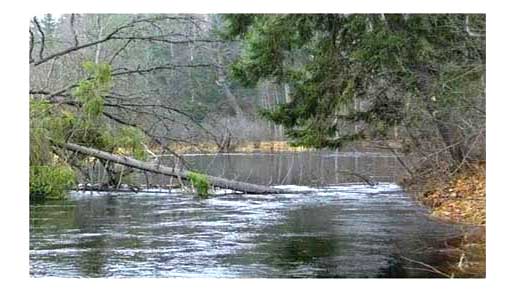
Good conditions for spring fishing with a half-bottom from the shore at the exit from the oxbow river are shown in the photograph. Please note that water is flowing out of the spill. This means that, higher up against the current, the branch of the oxbow lake in high water connects with the main channel of the river.
The site is in all respects suitable for spring fishing, both from the shore and from a boat, which is tied on short runs of twine to a tree fallen across the neck of the oxbow lake, then from the same side, that is, the current coming from the spring flood, a soft feeder is lowered.
On my fishing trips, and not only in the spring, the side feeder always lowers from the side of the incoming current, in this case from the side of the oxbow lake flooded in the spring by the flood waters.
Due to the shallow depth, the fish is caught on a long (four to five meters) descent of the line of the side bottom. You don’t even have to drive the weight of the tackle along the current; the lead ball will just drag it where you need it.
Spring fishing in the oxbow from a boat
Regarding the prospects of spring fishing from a rubber boat in the waters of the oxbow lake itself, I can give at least the following example from my more than many years of experience.
Somehow, in the first days of May, the catch in the morning of just one ide amounted to more than 10 kg. Of these, a dozen specimens weighed from 500 to 800 grams. The rest are small pieces of 120-150 grams.
I was fishing from a boat with one long rod between the trees flooded by the spring flood. In summer it is the shore of the oxbow. The boat is tied to a tree branch protruding from the water with twine.
I will share my experience of fishing in the oxbow lake at the height of the spring flood. I usually come fishing with one of my friends on weekends, starting from the beginning of May, and from year to year to the same place. On the oxbow, not even the river itself, but its channels at this time there are still pieces of ice.
For spring fishing I bring one of two rubber boats, usually a single-seater “swift”, which is more convenient to wade through the branches of trees and bushes flooded by floods. In the spring, when the river floods, I catch fish with only one float rod.
Nozzle for fishing in spring from a boat
I equip a telescopic fishing rod with a light float without a sinker. I simply drop the bait on the hook or jig into the desired fishing spot on the oxbow lake, and periodically move the float with the rod. Therefore, it is necessary to use a release relatively often.
As a bait for fishing in early spring, I usually use 2-3 grains of steamed pearl barley flavored with unrefined sunflower oil.
When fishing in spring from a boat, I throw baits into a feeding area under flood-flooded bushes near the shore of the oxbow lake. The ides grab the bait during or after the hook with pearl barley slowly sinks to the bottom of the reservoir.
I use the same bait material to sparingly feed spring fishing spots on an oxbow lake or other stagnant body of water. If you manage to get hold of maggots, underleaves or dung worms, then the chance of catching silver bream, sops, and dung worms instead of ide increases.
If a noticeable current appears in the oxbow lake at the fishing spot - closer to lunch, the spring sun warms up the air quite well, then I make changes to the equipment of the float rod: I put a float with a slightly larger carrying capacity and compress the fishing line with a small sinker 15 centimeters above the hook.
Tips for spring fishing from the shore
If spring fishing conditions allow, that is, there are no trees hanging over the place of fishing from the shore of the oxbow lake, the fisherman can plumb the jig from land. But for such fishing, it is advisable to first get hold of bloodworms, or small dung worms, or at least underleaf.
If desired, the underleaf can be found under the leaves on the sun-warmed shore of the oxbow lake. Then the range of catch caught on live bait will be much more diverse. Fish take earthworms less often, but are larger.
Against the background of fishing in high water on the flood of an oxbow river, several examples of spring fishing for crucian carp in a pond can be given. At least to feel the striking contrast of two spring fishing trips.
Brief description of floods
Many people think that it is pointless to fish when the water is rising, since fish do not feed in cloudy water. This is not entirely true. The fish feeds and even bites, but it is more difficult for them to find food.
There are two types of floods. The first type is weather floods, which occur as a result of temporary thaws or rainfall. The second type of flood occurs after the spring ice drift - spring flood. Depending on the duration of warming and the amount of precipitation, floods can be either with a slight rise in the water level and an increase in the strength of the current, or quite strong - which causes river overflow, even flooding.
A small high water, if it is not a flood, provides fishermen with a good opportunity to remain with a good catch. Even a slight increase in the water level enriches it with dissolved oxygen and a variety of animal food, which is carried away by streams - all this increases the activity of the fish, and as a result, the bite increases. But it should be noted that fishing in high water is usually better when the water is receding. At the beginning of the spring flood, due to the arrival of cold and melt water, the activity of the fish generally decreases - this happens because the metabolism of the fish slows down.
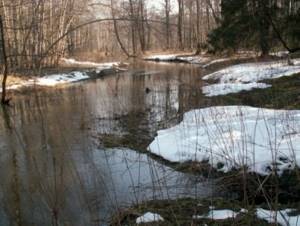
Flood after spring ice drift
Various particles of soil and lime, which are carried away by water flows, clog the gills and make it quite difficult for fish to breathe.
When the snow melting process begins to subside, the water gradually warms up, and the fish gradually begin to become more active. Various particles and turbidity are filtered and begin to settle. The water becomes clearer and cleaner. The fish begins to breathe easier, having become hungry during the muddy and cold water, and on the eve of spawning it begins to eat off.
Fishing in spring high water on a pond

I will provide some information about my fishing trips on one of the more frequently visited ponds during spring floods, where crucian carp is found, offering decent resistance on the hook of the tackle.
Repeated visits to many village ponds during the spring from May 1 to 9, casting baits to the depths and calculating the bites of large crucian carp, in terms of the effectiveness of catches, were equal to spring fishing in the nearest abandoned village well.
A completely different picture is observed in the shallows of the spill at the source of the pond. There, in high water when the water warms up around lunchtime, you can catch a lot of crucian carp, not differing in acceptable size and weight. For this reason, I go to ponds to catch crucian carp only a couple of weeks after the fish spawn.
In fact, I ignore fishing on the pond at the height of the spring flood, preferring to enjoy catching fish of other species on the river, or catching perch on the lakes with fry from a boat.
As for fishing in the spring on the pond, local boys at this time do a good job of catching perch with a worm below the water discharge through the dam. The gear used is float, tied on short rods. But I don’t really understand why very few crucian carp come up here from the flood below the dam.
Gear selection
Depending on the preferences of the fisherman and the conditions on the reservoir, you can use any fishing method:
- float rod (if the fish are concentrated in the coastal zone),
- bottom gear (if fishing occurs in remote areas),
- spinning (when the object of the hunt is a predatory fish).
8 float attachments
Basics of fishing
To help the novice fisherman
Catching a decent specimen during high water is almost impossible in the upper and middle layers of the river. Because of this, an important condition for any fishing method is to deliver and hold the bait closer to the bottom. When choosing gear, accompanying conditions will play a big role. For example, garbage rushing along the river during the spring flood will not allow you to fish with a spinning rod, and a strong wind will not allow you to fish with a float rod.
Spring fishing on the lake
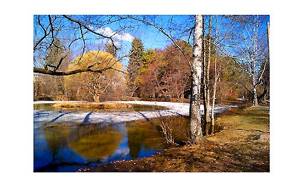
Spring fishing on lake spills, as well as on a pond, begins with the water warming up. And why fishermen prefer to visit enclosed or non-flowing bodies of water during spring floods, apparently, there is no particular need to explain.
So, it is clear that spring lakes, ponds and oxbow lakes after the ice melts are the cleanest, turbidity-free, oxygen-rich fishing sites. But the tackle should be configured to catch a specific fish, depending on the age group and well-thought-out fishing rod equipment.
Spring fishing starts in shallow silted areas, albeit flooded with melt water, which is understandable. In shallow lakes, where the water warms up faster, plant and animal fish food develops more intensively.
Therefore, in flooded lakes, ponds and oxbow lakes, even during early spring fishing, you can catch a lot of well-fed fish that have come out to feed and have developed eggs.
Fishing in the spring on the lake from a boat
For fishing in the spring on a lake from a boat, in my opinion, there is nothing better than a light, short bamboo fishing rod with a combined universal equipment.
Spring fishing is especially promising along the entire length of the channel flowing into the lake, connected to the bed of a small river flowing nearby. But it is better to throw the bait of fishing gear into the mouths of lake channels.
For me personally, fishing in the spring flood of the lake is more interesting from the shore than from a boat - you scare away the fish less.
Usually along the shoreline of the lake there are bushes flooded with spring flood waters, near which the intended hunting objects should be located. I tie the boat to these bushes with short guy ropes.
I don’t even take the anchors out of the car. I use the same groundbait, attachments and bait as on the oxbow river.
Spring fishing from the lake shore
For fishing from the shore on a lake flood, I prefer to use light fly rods up to 8-9 meters long with equipment configured for float fishing at a depth of up to one and a half meters.
Despite the fact that the flooded soil of the shore should be hard, it is better to raise the nozzle on the hook of the float rod above the bottom by 5-7 centimeters. Otherwise, the worm may end up in floating coastal debris.
Considering that on the flooded shore of the lake, as a rule, last year’s grass is present, which is the reason for removing the hooks, for reliable fishing, I load the tackle with a fishing line 0.22-0.25 mm thick with a leash of 0.18-0.2 mm.
Rest
Sestroretskoye Lake is of interest to vacationers and tourists. Holidays on Sestroretsky Razliv can be very varied: a picnic, a bike ride, mushroom picking, sightseeing, and some residents even swim, despite the fact that the water is considered unsuitable for this. Beaches, sports grounds, bicycle paths are equipped for vacationers, and restaurants are open. There is something to see here for both locals and tourists.
- Lenin's Hut , which is a museum complex dedicated to the stay of Lenin and Zinoviev in this place in 1917, who were forced to hide from arrest. The monument was opened in 1928. On the territory there is an imitation hut made of clay and reeds, a structure made of granite blocks and a large monument - a bust of Lenin. Despite the fact that during the Great Patriotic War it was located near the front line, the museum remained intact and became a place where soldiers of the Leningrad Front were awarded.
- The Sestroretsk Swamp reserve with an ecological trail has been operating since 2011. It reflects the realities of the area of the cultural capital, because it was on such swamps that the city was built. In 2021, an ecological trail was opened here, the entrance to which is on Zheleznodorozhnaya Street in the village of Beloostrov. This trail passes through a pine forest and swamps. Pedestrian wooden bridges, signs, trash cans, and toilets are installed along the entire length.
- ferry - the Shalash Museum opens from the end of May and is open until the onset of cold weather. It makes about a dozen flights every day for a fee. The duration of the trip one way is 15–20 minutes. The ferry offers beautiful views and is worth a ride.
Ferry on the Sestroretsky Razliv, ©
